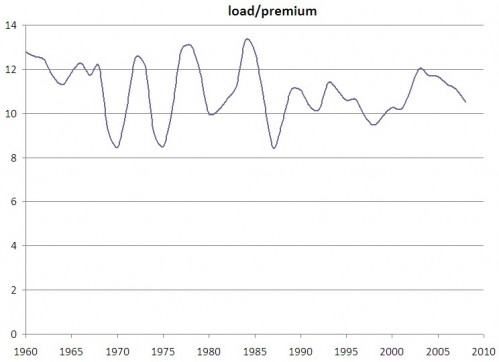Readers of this blog continue to write good comments and draw my attention to good papers, which comprise some of the content of my occasional Reading List posts. Since one of the purposes of this blog is to learn things I’m grateful for such feedback. Thank you!
A recent example came by e-mail. A reader sent me the time series illustrated below. It’s a time series of the ratio of health insurers’ aggregate “load” (non-medical expenses) to premiums, computed from historical National Health Expenditure data (which I verified). The vertical scale is percentage, the horizontal is year. Subtracting the plotted ratio from one yields the medical loss ratio (MLR), the proportion of premiums spent on health costs. That’s the quantity regulated by the ACA to be 85% for the large-group market and 80% for the small- and individual-group markets.
Notice that the load/premium ratio has not exceeded about 13%, corresponding to an MLR of 87%. Thus, on average, the MLR minimums of the new health care law won’t be binding. But this masks the heterogeneity of MLR by market. In the large-group market, MLRs are already about 85%, so the new law will still not bind in that market, on average. Those products must dominate the NHE figures because the small-group and individual markets have smaller MLRs, closer to 75% according to one recent study. Thus, the MLR minimums, if they do anything, will have their effect in the small- and non-group markets.
Meanwhile, co-blogger Steve Pizer and I have had some discussions about what the MLR minimums might do and how they’re similar, or not, to other types of rate regulations. My thoughts ended up in a Kaiser Health News column, where I suggested MLR regulation won’t solve the cost problem. Here’s what Steve wrote about it in a recent e-mail:
MLRs are similar to rate of return regulation of monopoly utilities, as existed for phone companies. There, deregulation reduced costs, which suggests MLR minimums won’t help. But nobody is proposing to replace competitive insurance markets with regulated monopolies. The purpose of loss ratio regulation is to prevent the kind of rate hikes proposed in California this year–rate hikes without a basis in observed rising costs. Why would a carrier in a competitive market do such a thing? Because they’re anticipating a cost spike or because they just took a big hit in investment income. I think the practical effect of loss ratio regulation will be to smooth out the underwriting cycle, preventing premium spikes when investments drop but also reducing price wars when investments are doing well. This seems to me to be a reasonable goal, although the burden in red tape will be substantial. I agree with you that it does next to nothing about cost growth.
Steve’s insight that MLR minimums will help consumers by smoothing premium growth is not something I had considered. We’ll see if he’s right. Regardless, I’ve learned a lot about MLRs from readers. Score one for blogging!



